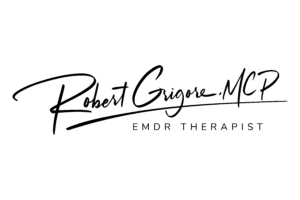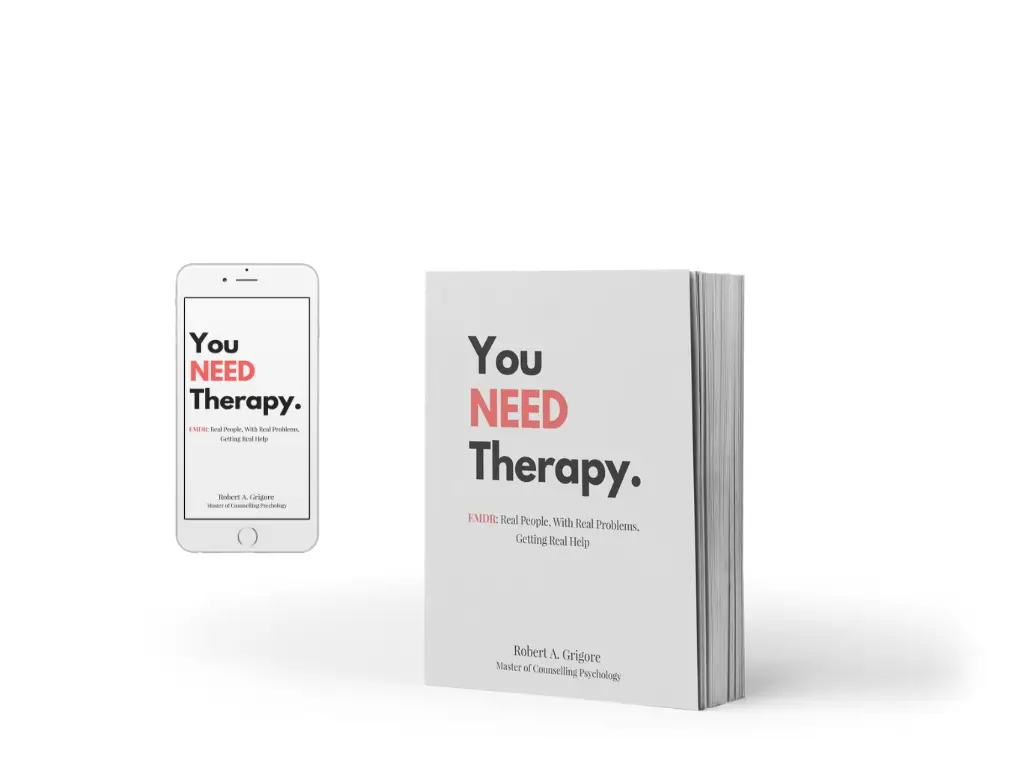If you’ve ever faced substance or behaviourally-related self-sabotage before, you will know personally how tight it can grip you…and how it never wants to let you go.
Some days you feel that you’re in complete control…other days, you feel that you have zero ability to resist your temptations.
Sometimes when you’re going good, it takes just a little skip in your stride for it all to come tumbling down. Sometimes the “going good” is enough to make it start to “go bad” again. Never mind any holiday or excuse to get wrecked–the mind can rationalize its use for anything.
It doesn’t matter if you’re hooked on sex, alcohol, cocaine, gambling, shopping, methamphetamine, heroin, work, or working out–anything performed to excess can ruin your life.
This blog post will cover 3 important areas:
1. Why people use a substance or engage in the problem behaviour.
2. Why EMDR is my preferred method for treating all forms of self-sabotage (*hint because it works) and NOT a 12-step model.
3. How EMDR can help (WAY faster than one might think).
1. Why People Use a Substance or Engage in Problem Behaviours.
According to the AIP Model of Change (Adaptive Information Processing Model of Change), individuals engage in problematic substance or behaviours for two reasons: avoidance or connection.
A.) Avoidance.
They experience first an extremely uncomfortable emotion (say anger, grief, hopelessness, etc.), and they have learned to “manage” that discomfort by using a substance or engaging in a behaviour.
The individual notices a reduction in the intensity or the elimination of the distress in the emotion, and the brain essentially tells the individual, “Good job, you figured out how to survive that distress.” (Emotional distress to the brain is experienced very much the same as physical distress.)
Each time that same distress is experienced, the brain “triggers” the same survival strategy it used to avoid that pain in the past–in this case the substance or behaviour.
This “strategy” to avoid the distressing feeling will “work” for different amounts of time for each person, but eventually, the neurological pathway will “win” and the individual’s life will begin to suffer in some unacceptable way (this generally makes the individual experience shame or guilt). This new added layer of distressing emotion becomes another “trigger” to use. And on, and on, and on the cycle goes: the individual experiences distress and they seek out the substance or engage in the behaviour in hopes that they will be able to avoid the distressing feeling.
B. Connection.
The second reason that individuals use or engage in problematic behaviours is to actually confront a difficult emotion that they otherwise cannot connect with.
Because the emotion or feeling is experienced as threatening in some way to the individual while sober (either they are afraid of the consequences, or they feel they lack the ability to effectively experience it), the behaviour provides a “buffer” or “gateway” for the individual to experience the emotion.
Thus, the substance or behaviour is used as a “tool” to help the individual unlock their otherwise “hidden” ability to feel the emotion.
Unfortunately, the individual’s desire to connect with their feelings become a trigger to use or act in their self-sabotaging behaviour. Shame and/or guilt quickly become added distress to the emotional equation, and then the behaviour begins to become something entirely more destructive.

2. Why EMDR is my preferred method for treating
self-sabotaging behaviour and NOT a 12-step model.
O.K., first thing’s first. If you or someone you know is receiving help from a 12-step model of care, that’s really great. I certainly recommend to keep with what’s working for you.
However, in my humble (and somewhat informed) opinion, the 12-step model of recovery is really about “symptom management.” While the social support element of most 12-step programs is really “second to none,” it’s simply not enough.
Most individuals who rely solely upon this type of treatment, often describe that their urges to use rarely subside, and typically, their triggers also do not abate. I imagine individuals “white-knuckling” their way through their life, resigned to remain in a battle between their “good” and their “bad” choices.
Inevitably, the triggers will almost always win (certainly more often at first), and from my professional experience, I have noted that some 12-step philosophies regard relapse as “failure,” and this causes many to experience shame.
If you remember from above, “shame” is one of the consequences of using, as well as it being an uncomfortable emotion that individuals are often trying to avoid. Feeling intense emotional discomfort tends to trigger a relapse. To me, I see this form of treatment as disempowering.
On the flip side, some 12-step models incorporate relapses into the phases of treatment — “It’s part of the program,” they’ll say.
It’s confusing for the client either way.
Enter EMDR.
EMDR treatment for substances and negative behaviours is revolutionary–not only in the speed for which it works, but in the quality of the treatment. Since A.J. Popky first began utilizing EMDR to treat individuals his DeTUR Model of treatment, the scope of how EMDR can effectively be used to free people of their self-sabotaging behaviour has grown considerably. Robert Miller and his Impulse Control Disorder Protocol is a great example of this.
One of the first things that an EMDR therapist will tell their new client when he or she is entering treatment for self-sabotaging behaviours, is that the goal of treatment does not have to be abstinence. If the client’s goal is to abstain from the behaviour completely, than that is the clinician’s goal as well. But if the client is looking for more control over their behaviour, then that is the clinician’s goal too.
Relapse is regarded as completely normal and not a reflection of the individual’s worth. For example: there are plenty of people in the world who smoke cigarettes and are good people; likewise, there are also plenty of people in the world who smoke and are very nasty people; whether the person smokes or not, is not the determining factor of their worth.
While outside support is seen as useful for treatment, it is not the focus—eliminating the urges, or the desired feeling that the behaviour produces, is the focus.
Let me repeat that: eliminating the urges or the desired feeling to use or engage in the problematic behaviour is the focus of treatment.
EMDR treatment is the real deal. We aren’t talking about masking the problem with a fancy motto or strict routine, nor are we talking about trading one unhealthy behaviour for a “healthier option.” No. We’re talking about eliminating the underlying cause altogether.
Look, people don’t wake up one morning and all-of-a-sudden say to themselves, “I think I’m going to become a drinker today…” People become used to something because the behaviour provides them with something that they are otherwise missing: relief, positive feelings, positive states, avoidance of distress, ways of coping, etc.
Anything can become a self-sabotaging behaviour.
And any self-sabotaging behaviour can be treated with EMDR.

3. How EMDR can help (WAY faster than one might think).
For those who are used to working only with CBT, 12-step models, or psychological medications, treatment for can take considerable time…sometimes even a lifetime. That’s a heck of a long time for me to imagine struggling. In that amount of time, one could lose their job, their marriage could fall apart, heck they could even kill themselves.
EMDR can help in a matter of sessions. Not years.
With Popky’s DeTUR Protocol, individuals can expect to identify their goals for treatment (the underlying reasons for why they want to undergo treatment…hint* it’s NOT just to be free of the patterns…it’s something greater than that). Afterwards, the individual is lead through some exercises to experience the true possibility of this change. Next, together with the clinician, the client’s focus of treatment will be either the future goal, the specific triggers which elicit the urge to use, or underlying traumatic events (i.e. the root cause[s]).
If the behavioural pattern first began due to some horrible event that was never worked through, then working through that issue becomes a primary focus (either at the start of treatment or later if that’s the time when the event surfaces in treatment).
Usually there is one or more negative belief about the person that needs to be identified and worked through, along with the triggers.
With Miller’s Impulse Control Disorder Protocol, the focus of treatment is actually on the desired positive feeling state that occurs when engaging in the compulsive behaviour.
That’s right. Treatment begins by identifying what the individual gets out of engaging in the behaviour or using the substance. This is usually a positive feeling (such as relief, excitement, joy, belonging, etc.) and positive belief about the self (such as, “I’m loved,” “I am ok,” “I’m a winner,” etc.).
Just as overwhelming negative events can become locked in “state-specific form” in the brain, and need to be worked through with EMDR, overwhelmingly positive events can become locked in the brain as well. It’s these positive events (the feeling and belief about the self) that need to be worked through with EMDR.
Miller discovered that if treatment focuses upon lowering the intensity of the positive feelings that the individual receives while engaging in the behaviour, then the underlying negative beliefs about the self begin to surface. Treatment then focuses on the negative beliefs, and afterwards, upon installing positive beliefs about the self instead.
Both Miller’s and Popky’s treatments focus upon installing healthier states and behaviours when needed. Both regard relapse as important information that becomes material to be worked through in treatment. Both treatments work faster than traditional talk-therapy, and 12-step programs. Both treatments are geared towards helping the individual attain the level of control he or she wants in life. Both treatments are recommended by us.
We wish you, or your loved one a healthy, speedy transformation.
____________________
If you enjoyed this post, please share with your friends! Like and/or comment, we love hearing your thoughts 🙂
With care and respect,












